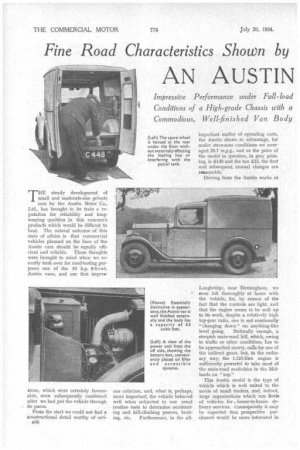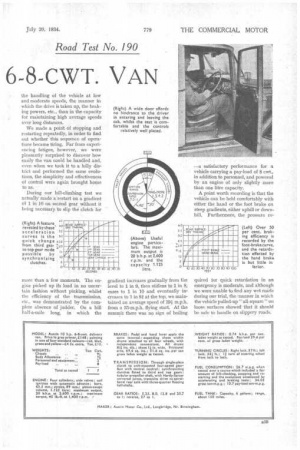Fine Road Characteristics Shown by
Page 52

Page 53

Page 54

If you've noticed an error in this article please click here to report it so we can fix it.
AN AUSTIN
6.8-CWT. VAN
Impressive Performance under Full-load Conditions of a High-grade Chassis with a Commodious, Well-finished Van Body
THE steady development of small and moderate-size private cars by the Austin Motor Co., Ltd., has brought in its train a reputation for reliability and longwearing qualities in this concern's products which would be difficult to beat. The natural outcome of this state of affairs is that commercial vehicles planned on the lines of the Austin cars should be equally efficient and reliable. These thoughts were brought to mind when we recently took over for road-testing purposes one of the 10 h.p. 6-8-cwt. Austin vans, and our first impres
Lions, which were certainly favourable, were subsequently confirmed after we had put the vehicle through its paces.
From the start we could not find a constructional detail worthy of serin38
ous criticism, and, what is, perhaps, more important, the vehicle behaved well when subjected to our usual routine tests to determine accelerating and hill-climbing powers, brak ing, etc. Furthermore, in the all
important matter of operating costs, the Austin shows to advantage, for under strenuous conditions we averaged 26.7 m.p.g., and as the price of the model in question, in grey priming, is £148 and the tax £15, the first and subsequent annual charges are reasonable,
Driving from thi) Austin works at Longbridge, near Birmingham, we soon felt thoroughly at home with the vehicle, for, by reason of the fact that the controls are light, and that the engine seems to be well up to its work, despite a relatively high top-gear ratio, one is not continually "changing down" on anything-like level going. Naturally enough, a steepish main-road hill, which, owing to traffic or other conditions, has to be approached slowly, cans for one of the indirect gears, but, in the ordinary way, the 1.125-litre engine is sufficiently powerful to take most of the main-road acclivities in the Midlands on "top."
This Austin model is the type of vehicle which is well suited to the needs of small traders, and, indeed, large organizations which run fleets of vehicles for 4,house-to-house delivery services. Consequently it may be expected that prospective purchasers would be more interested in
the handling of the vehicle at low and moderate speeds, the manner in which the drive is taken up, the braking powers, etc.. than in the capacity for maintaining high average speeds over long distances.
We made a point of stopping and restarting repeatedly, in order to find out whether 'this sequence of operations became tiring. Far from experiencing fatigue, however, we were pleasantly surprised to discover how easily the van could be handled and, even when we tool it to a hilly district and performed the same evolutions, the simplicity and effectiveness of control were again brought home to us.
During our hill-climbing test we actually made a restart on a gradient 6f 1 in. 10 on second gear without it being necessary to slip the. dutch for more than a few moments. The engine picked up ifs load in no uncertain fashion without pinking, whilst the efficiency of the transmission, etc.. was demonstrated by the complete absence of judder. On a hill half-a-mile long, in which the
gradient increases gradually from the level to 1 in 9, then stiffens to 1 in 8, eases to 1 in 10 and eventually increases to 1. in 8f at the top, we maintained an average speed of 19i m.p.h. from a 35-m.p.h. flying start. Af the summit there was no sign of boiling --a satisfactory performance for a vehicle carrying a pay-load of 8 cwt., in addition to personnel, and powered by an engine of only slightly more than one litre capacity. A point worth recording is that the vehicle can be held comfortably with either the hand or the foot brake on steep gradients, either uphill or downhill. Furthermore, the pressure re
quired for quick retardation in an emergency, is moderate, and although we were unable found any wet roads during our trial, the manner in which the vehicle pulled-up `` all-square" on 'loose surfaces showed that it should be safe to handle on slippery roads.
The steering quality of all Austin vehicles has always been a matter calling for favourable comment, and this 8-cwt. van is no exception to the rule. One can steer this model to mere inches at high speeds, the wheel action being free from kick—a point which shows that the mechanics of the suspension system and steering gear are correct. On the other hand, when manceuvring in confined spaces, the steering is light, yet this easy movement has not been obtained by giving the steering mechanism a low gear ratio.
Another feature worth recording concerns the suspension. A happy compromise, between the relative spring strengths at the front and rear and the damping effect upon both pairs of springs, has been hit, for at high speeds the vehicle is quite
steady, with little tendency towards rolling or pitching, 'yet when running over rough roads at low speeds, say between 5 m.p.h. and 20 m.p.h., the springing is not harsh.
A few remarks may here be interposed concerning the carrying capa city of the van body. The respective length, width i and height dimensions of
on), 4 ft. 1 in. and 3 ft.
' 8 ins., give an interior capacity of approximately 63 cubic ft„ allowing for the interference caused by the wheel-arches, etc.; the loading height is 1 ft.
T 10i ins. Entrance and
exit to and from the seats is simple, for there are two doors to the driving compartment and, as the width of each doorway is no less than 2 ft. 4i ins., little obstruction is offered.
Complete equipment is provided, a 12-volt lighting and starting system being installed, together with an electric screen-wiper, horn, stop lamp, etc., in addition to the usual side and head lamps. Direction indicators, a clock, a speedometer, and the use of Triplex glass are other features.




























































































